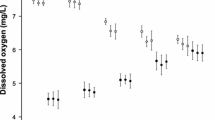Abstract
The interactions between pH, metals, and water hardness in determining the suitability of vernal ponds for amphibian reproduction were investigated through a fully factorial laboratory microcosm experiment. Naturally-occurring metals (Al, Cu, Fe, Pb, Zn) at concentrations analogous to those observed in prior field studies had variable effects on acute (7 day) and chronic (28 day) exposure survival for both the Jefferson salamander, Ambystoma jeffersonianum, and the wood frog, Rana sylvatica. Acute exposure to Al and Cu significantly reduced wood frog survival; increased water hardness significantly increased acute exposure wood frog survival. Acute exposure mortality of the Jefferson salamander was significantly higher in the Al and Cu treatments; in toxic metal treatments (Al and Cu), survival was higher at the low pH level. Chronic exposure of wood frogs to Al and Cu, higher pH level, and lower hardness levels greatly reduced survival. Chronic exposure of Jefferson salamander larvae to Al and Cu significantly reduced survival. Chronic Jefferson salamander survival was significantly greater in the higher pH treatments in the presence of non-toxic metals, however, survival was significantly decreased in the higher pH treatments in the presence of Al and Cu. There were no statistically significant effects of metals, pH, or hardness on wet mass of the pre-metamorphic larvae.
The four conditions tested (pH, hardness, presence of metals, and amphibian species) are important determinants of toxicity observed in temporary pond amphibian breeding sites. Clearly, there is no single water chemistry parameter that can explain the toxicity of temporary ponds to the embryos and larvae of terrestrial amphibians that use the ponds for breeding.
Similar content being viewed by others
References
Beattie RC, Tyler-Jones R (1992) The effects of low pH and aluminum on breeding success in the frog Rana temporaria. J Herp 26:353–360
Blem CR, Blem LB (1989) Tolerance of acidity in a Virginia population of the spotted salamander Ambystoma maculatum (Amphibia: Ambystomatidae). Brimleyana 15:37–45
Clark KL (1986) Responses of the spotted salamander, Ambystoma maculatum, populations in central Ontario to habitat acidity. Can Field Naturalist 100:463–469
Clark KL, Hall RJ (1985) Effects of elevated hydrogen ion and aluminum concentration on the survival of amphibian embryos and larvae. Can J Sci 42:116–123
Clark KL, LaZerte BD (1987) Intraspecific variation in hydrogen ion and aluminum toxicity in Bufo americanus and Ambystoma maculatum. Can J Fish Aquat Sci 44:1622–1628
Dale JM, Freedman B, Kerekes J (1985) Experimental studies of the effects of acidity and associated water chemistry on amphibians. Proc N S Inst Sci 35:35–54
Dunson WA, Connell J (1982) Specific inhibition of hatching in amphibian embryos by low pH. J Herp 3:314–316
Dunson WA, Wyman RL, Corbett ES (1992) A symposium on amphibian declines and habitat acidification. H Herp 26:349–352
Freda J (1986) The influence of acidic pond water on amphibians: A review. Water Air Soil Pollut 20:439–450
— (1991) The effects of aluminum and other metals on amphibians. Environ Poll 71:305–328
Freda J, Dunson WA (1985a) The influence of external cation concentration on the hatching of amphibian embryos in water of low pH. Can J Zool 63:2649–2656
--, -- (1985b) The effect of acidic precipitation on amphibian breeding in temporary ponds of Pennsylvania. US Fish and Wildlife Service, Eastern Energy and Land Use Team. Biol Rep 80(40.22), 85 pp
Freda J, McDonald DG (1990) Effects of aluminum on the leopard frog, Rana pipiens: Life stage comparisons and aluminum uptake. Can J Fish Aquat Sci 47:210–216
Harfenist A, Power T, Clark KL, Peakall DB (1989) A review and evaluation of the amphibian toxicological literature. Technical Report #61, Canadian Wildlife Service Headquarters
Horne MT, Dunson WA (1994) Exclusion of the Jefferson salamander, Ambystoma jeffersonianum, from some potential breeding ponds in Pennsylvania: Effects of pH, temperature, and metals on embryonic development. Arch Environ Contam Toxicol 27:323–330
--, -- (1995a) Toxicity of metals and low pH to embryos and larvae of the Jefferson salamander Ambystoma jeffersonianum (in press Arch Environ Contam Toxicol)
--, -- (1995b) The interactive effects of low pH, metals, and DOC on a simulated temporary pond community. (in press Environmental Pollution)
--, -- The hydrology of metal and pH fluctuations in vernal amphibian breeding ponds of central Pennsylvania. (submitted Wetlands)
McDonald DG, Freda J, Cavdek V, Gonzalez R, Zia S (1991) Interspecific differences in gill morphology of freshwater fish in relation to tolerance of low-pH environments. Physio Zool 64:124–144
McDonald DG, Wood CM (1993) Branchial mechanisms of acclimation to metals in freshwater fish. In: JC Rankin, FB Jensen (eds.) Fish Ecophysiology. Chapman and Hall, London
Neter J, Wasserman W, Kutner MH (1990) Applied Linear Statistical Models: Regression, Analysis of Variance, and Experimental Designs, 3rd ed. Richard D. Irwin, Inc. Homewood, IL, 1181 pp
Pierce BA (1985) Acid tolerences in amphibians. Bioscience 35:239–243
Rowe CL, Dunson WA (1993) Relationships among abiotic parameters and breeding effort by three amphibians in temporary wetlands of central Pennsylvania. Wetlands 13:237–246
Rowe CL, Sadinski WJ, Dunson WA (1992) Effects of acute and chronic acidification on three larval amphibians that breed in temporary ponds. Arch Environ Contam Toxicol 23:339–350
Sadinski WJ (1991) Direct and indirect effects of low pH on the communities of temporary ponds. PhD thesis, The Pennsylvania State University, University Park, PA
Sadinski WJ, Dunson WA (1992) A multi-level study of the effects of low pH on amphibians of temporary ponds. J Herp 26:413–422
Author information
Authors and Affiliations
Rights and permissions
About this article
Cite this article
Horne, M.T., Dunson, W.A. Effects of low pH, metals, and water hardness on larval amphibians. Arch. Environ. Contam. Toxicol. 29, 500–505 (1995). https://doi.org/10.1007/BF00208380
Received:
Revised:
Issue Date:
DOI: https://doi.org/10.1007/BF00208380




